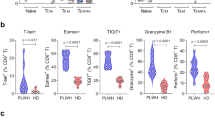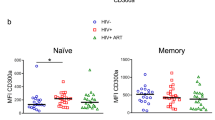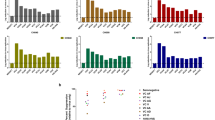Abstract
Functional impairment of T cells is characteristic of many chronic mouse and human viral infections. The inhibitory receptor programmed death 1 (PD-1; also known as PDCD1), a negative regulator of activated T cells1,2,3,4, is markedly upregulated on the surface of exhausted virus-specific CD8 T cells in mice5. Blockade of this pathway using antibodies against the PD ligand 1 (PD-L1, also known as CD274) restores CD8 T-cell function and reduces viral load5. To investigate the role of PD-1 in a chronic human viral infection, we examined PD-1 expression on human immunodeficiency virus (HIV)-specific CD8 T cells in 71 clade-C-infected people who were naive to anti-HIV treatments, using ten major histocompatibility complex (MHC) class I tetramers specific for frequently targeted epitopes. Here we report that PD-1 is significantly upregulated on these cells, and expression correlates with impaired HIV-specific CD8 T-cell function as well as predictors of disease progression: positively with plasma viral load and inversely with CD4 T-cell count. PD-1 expression on CD4 T cells likewise showed a positive correlation with viral load and an inverse correlation with CD4 T-cell count, and blockade of the pathway augmented HIV-specific CD4 and CD8 T-cell function. These data indicate that the immunoregulatory PD-1/PD-L1 pathway is operative during a persistent viral infection in humans, and define a reversible defect in HIV-specific T-cell function. Moreover, this pathway of reversible T-cell impairment provides a potential target for enhancing the function of exhausted T cells in chronic HIV infection.
This is a preview of subscription content, access via your institution
Access options
Subscribe to this journal
Receive 51 print issues and online access
$199.00 per year
only $3.90 per issue
Buy this article
- Purchase on Springer Link
- Instant access to full article PDF
Prices may be subject to local taxes which are calculated during checkout




Similar content being viewed by others
References
Ishida, Y., Agata, Y., Shibahara, K. & Honjo, T. Induced expression of PD-1, a novel member of the immunoglobulin gene superfamily, upon programmed cell death. EMBO J. 11, 3887–3895 (1992)
Nishimura, H., Nose, M., Hiai, H., Minato, N. & Honjo, T. Development of lupus-like autoimmune diseases by disruption of the PD-1 gene encoding an ITIM motif-carrying immunoreceptor. Immunity 11, 141–151 (1999)
Sharpe, A. H. & Freeman, G. J. The B7–CD28 superfamily. Nature Rev. Immunol. 2, 116–126 (2002)
Chen, L. Co-inhibitory molecules of the B7–CD28 family in the control of T-cell immunity. Nature Rev. Immunol. 4, 336–347 (2004)
Barber, D. L. et al. Restoring function in exhausted CD8 T cells during chronic viral infection. Nature 439, 682–687 (2006; published online 28 December 2005)
Migueles, S. A. et al. HIV-specific CD8+ T cell proliferation is coupled to perforin expression and is maintained in nonprogressors. Nature Immunol. 3, 1061–1068 (2002)
Lichterfeld, M. et al. Loss of HIV-1-specific CD8+ T cell proliferation after acute HIV-1 infection and restoration by vaccine-induced HIV-1-specific CD4+ T cells. J. Exp. Med. 200, 701–712 (2004)
Kostense, S. et al. Persistent numbers of tetramer+ CD8+ T cells, but loss of interferon-γ+ HIV-specific T cells during progression to AIDS. Blood 99, 2505–2511 (2002)
Kostense, S. et al. High viral burden in the presence of major HIV-specific CD8+ T cell expansions: evidence for impaired CTL effector function. Eur. J. Immunol. 31, 677–686 (2001)
Goepfert, P. A. et al. A significant number of human immunodeficiency virus epitope-specific cytotoxic T lymphocytes detected by tetramer binding do not produce gamma interferon. J. Virol. 74, 10249–10255 (2000)
Appay, V. et al. HIV-specific CD8+ T cells produce antiviral cytokines but are impaired in cytolytic function. J. Exp. Med. 192, 63–75 (2000)
Zhang, D. et al. Most antiviral CD8 T cells during chronic viral infection do not express high levels of perforin and are not directly cytotoxic. Blood 101, 226–235 (2003)
Rosenberg, E. S. et al. Vigorous HIV-1-specific CD4+ T cell responses associated with control of viremia. Science 278, 1447–1450 (1997)
Kiepiela, P. et al. Dominant influence of HLA-B in mediating the potential co-evolution of HIV and HLA. Nature 432, 769–775 (2004)
Steiner, K. et al. Enhanced expression of CTLA-4 (CD152) on CD4+ T cells in HIV infection. Clin. Exp. Immunol. 115, 451–457 (1999)
Tsomides, T. J. et al. Naturally processed viral peptides recognized by cytotoxic T lymphocytes on cells chronically infected by human immunodeficiency virus type 1. J. Exp. Med. 180, 1283–1293 (1994)
Yang, O. O. et al. Efficient lysis of human immunodeficiency virus type 1-infected cells by cytotoxic T lymphocytes. J. Virol. 70, 5799–5806 (1996)
Loffredo, J. T. et al. Tat28–35SL8-specific CD8+ T lymphocytes are more effective than Gag181–189CM9-specific CD8+ T lymphocytes at suppressing simian immunodeficiency virus replication in a functional in vitro assay. J. Virol. 79, 14986–14991 (2005)
Champagne, P. et al. Skewed maturation of memory HIV-specific CD8 T lymphocytes. Nature 410, 106–111 (2001)
Appay, V. et al. Memory CD8+ T cells vary in differentiation phenotype in different persistent virus infections. Nature Med. 8, 379–385 (2002)
Hess, C. et al. HIV-1 specific CD8+ T cells with an effector phenotype and control of viral replication. Lancet 363, 863–866 (2004)
Day, C. L. & Walker, B. D. Progress in defining CD4 helper cell responses in chronic viral infections. J. Exp. Med. 198, 1773–1777 (2003)
Trabattoni, D. et al. B7–H1 is up-regulated in HIV infection and is a novel surrogate marker of disease progression. Blood 101, 2514–2520 (2003)
Altman, J. D. et al. Phenotypic analysis of antigen-specific T lymphocytes. Science 274, 94–96 (1996)
Dorfman, D. M., Brown, J. A., Shahsafaei, A. & Freeman, G. J. Programmed death-1 (PD-1) is a marker of germinal center-associated T cells and angioimmunoblastic T cell lymphoma. Am. J. Surg. Pathol. 30, 802–810 (2006)
Brown, J. A. et al. Blockade of programmed death-1 ligands on dendritic cells enhances T cell activation and cytokine production. J. Immunol. 170, 1257–1266 (2003)
Acknowledgements
This work was supported by a Royal Society postdoctoral fellowship (C.L.D.), the Harvard University Center for AIDS Research (D.E.K. and B.D.W.), grants from the Doris Duke Charitable Foundation (B.D.W.), the NIH (B.D.W., G.J.F., R.A., P.J.R.G.), the Howard Hughes Medical Institute (B.D.W.); a grant from the Foundation for the National Institutes of Health through the Grand Challenges in Global Health initiative (G.J.F. and R.A.), a contract from the NIH (B.D.W.), and the Mark and Lisa Schwartz Foundation. We thank S. Chetty, N. Ismail, N. Mkhwanazi, K. Nair, A. Piechocka-Trocha, A. Rathod and M. Vanderstock for technical assistance.
Author information
Authors and Affiliations
Corresponding author
Ethics declarations
Competing interests
Reprints and permissions information is available at www.nature.com/reprints. The authors declare no competing financial interests.
Supplementary information
Supplementary Notes
This file contains Supplementary Figures 1–4 and Supplementary Table 1. These figures provide supporting data indicating that PD-1 expression is associated with functional impairment of HIV-specific CD8 T cells, and that PD-1 expression on HIV-specific CD8 T cells and total CD8 T cells is associated with viral load and absolute CD4 count. Supplementary Table 1 lists the MHC Class I tetramers used in this study. (PDF 1041 kb)
Rights and permissions
About this article
Cite this article
Day, C., Kaufmann, D., Kiepiela, P. et al. PD-1 expression on HIV-specific T cells is associated with T-cell exhaustion and disease progression. Nature 443, 350–354 (2006). https://doi.org/10.1038/nature05115
Received:
Accepted:
Published:
Issue Date:
DOI: https://doi.org/10.1038/nature05115
This article is cited by
-
PD-1 defines a distinct, functional, tissue-adapted state in Vδ1+ T cells with implications for cancer immunotherapy
Nature Cancer (2024)
-
IFN-γ decreases PD-1 in T lymphocytes from convalescent COVID-19 patients via the AKT/GSK3β signaling pathway
Scientific Reports (2024)
-
Bispecific antibodies promote natural killer cell-mediated elimination of HIV-1 reservoir cells
Nature Immunology (2024)
-
Clinical significance of B7-H3 expression in circulating CD4+CD25high T cells, CD14+ monocytes, and plasma for the progression of HIV infection
BMC Infectious Diseases (2023)
-
Use of programmed cell death protein 1 (PD-1) inhibitor therapy in HIV-infected patients with advanced cancer: a single-center study from China
Infectious Agents and Cancer (2023)
Comments
By submitting a comment you agree to abide by our Terms and Community Guidelines. If you find something abusive or that does not comply with our terms or guidelines please flag it as inappropriate.



